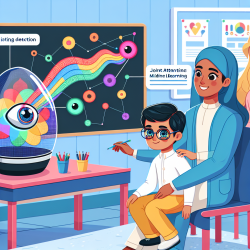In the quest to improve emotional language comprehension among children, the research article titled "The Functional Role of the Periphery in Emotional Language Comprehension" by Havas and Matheson offers valuable insights. This study delves into how peripheral feedback, particularly facial expressions, influences our understanding of emotional language. As practitioners focused on data-driven decisions, integrating these findings can significantly enhance therapy outcomes for children.
The core premise of the research is that facial feedback provides context-sensitive constraints on the simulation of actions described in language. This means that when children read or hear emotionally charged sentences, their facial expressions (smiling, frowning) play a crucial role in how they comprehend the emotional content.
Here are some key takeaways from the research and how they can be applied in practice:
- Facial Expressions Accompany Emotional Shifts: Just as facial expressions accompany sudden shifts in wellbeing in real-world situations, they do so during language comprehension. Encouraging children to be aware of their facial expressions while reading can enhance their understanding of emotional content.
- Modulation of Emotional Action Systems: Facial expressions modulate emotional action systems during reading. This means that a child's facial feedback can either facilitate or hinder their comprehension based on the congruence of their expression with the emotional content. Practitioners can use this insight to develop exercises that align facial expressions with reading material.
- Preparation for Effective Simulation: Emotional action systems prepare the reader for an effective simulation of the ensuing language content. This suggests that incorporating activities that engage both facial expressions and reading can lead to better comprehension outcomes.
To implement these findings, consider the following strategies:
- Interactive Reading Sessions: Create interactive reading sessions where children are encouraged to express emotions through their faces as they read. This can be done through role-playing or guided reading activities.
- Facial Feedback Exercises: Develop exercises that focus on facial feedback. For instance, use mirrors or video recordings to help children become more aware of their facial expressions and how they correlate with the emotional content of the text.
- Emotionally Charged Content: Use reading materials that are rich in emotional content and encourage children to discuss their feelings and facial expressions during and after reading. This can help them connect their emotional experiences with the language.
By integrating these strategies into your practice, you can enhance children's emotional language comprehension, leading to better therapy outcomes. Encouraging further research in this area can also contribute to developing more effective therapeutic techniques.
To read the original research paper, please follow this link: The Functional Role of the Periphery in Emotional Language Comprehension.










